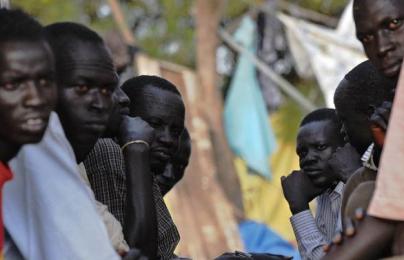FAO says South Sudan will face severe hunger between January and March
February 8, 2016 (JUBA) -The Food and Agriculture Organization (FAO) of the United Nations said an estimate of 2.8 million people equivalent to 23% of South Sudanese population will face acute food and nutrition insecurity between January and March this year. The bulk of this acutely food insecure population, 57 per cent are located in the Greater Upper Nile states of Unity, Jonglei and Upper Nile.

“Based on the reconnaissance mission conducted in November 2015 by the IPC, there is overwhelming evidence of a humanitarian emergency in Mayendit, Koch, Leer and Guit counties, where displaced communities are destitute and surviving using severe coping strategies such as water lilies,” the FAO statement extended to Sudan Tribune says.
The report has indicated presence of famine is likely to occur and lack of access to some of the locations due to ongoing fighting is making situation deteriorate further during the January to March 2016.
As a result, the Integrated Food security Phase Classification or IPC has estimated that 40,000 people are likely to be facing humanitarian catastrophe between January and March and are in need of urgent food and other humanitarian assistance to avoid any further deterioration and escalation.
The report also cited humanitarian concerns in some parts of Bahr el Ghazal and Equatoria regions due to famine and local insecurity incidents.
“An additional 200,000 people have moved from Stressed to Crisis classification in Northern Bahr El Ghazal, Warrap and Eastern Equatoria states. The food security crisis in these states is caused by disrupted trade, also due to localized insecurity and reduced crop harvests, which is contrary to what was forecasted during the September 2015 analysis,” it says.
The primary reason for the deterioration is the prolonged dry spell, which was projected to cease by the end of September. Localized insecurity also affected agricultural activities, a main source of income in the Equatoria region, during the production season.
Market functionality throughout the country has been affected mainly due to the depreciation of the local currency, and most traders are not restocking resulting in scarcity of commodities with high prices.
The recent trader surveys done between October and December last year shown that in Juba, many traders are going out of business as cereal prices hit record high prices, in December 2015, 3.5kg Sorghum sold at 100 SSP, compared to 9 SSP in December 2014.
The recent change in local currency exchange rate policy warrants close monitoring with regard to its impact on food trade, markets and consumption.
Analysis of humanitarian food assistance shows that less than one fifth of the total population in the counties is receiving lifesaving food, and based on IPC cut-off criteria this is insufficient impact to upgrade the food security classification in most counties, apart from a few counties in Jonglei state.
Moreover, in the other states where some humanitarian assistance has taken place, it has not been consistent due to insecurity limiting its impact on the livelihoods and food consumption of vulnerable households.
The report said generally speaking, the nutrition situation remains “very critical” particularly in Unity, Jonglei, Warrap, Northern Bahr el Ghazal and parts of Eastern Equatoria states where the prevalence of Global Acute Malnutrition (GAM) is above emergency thresholds of15%.
.
(ST)
